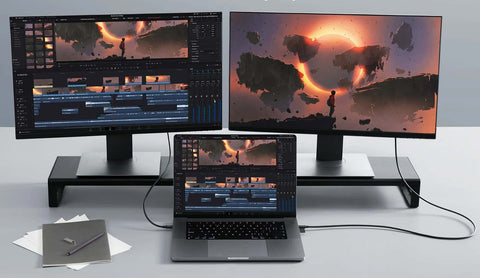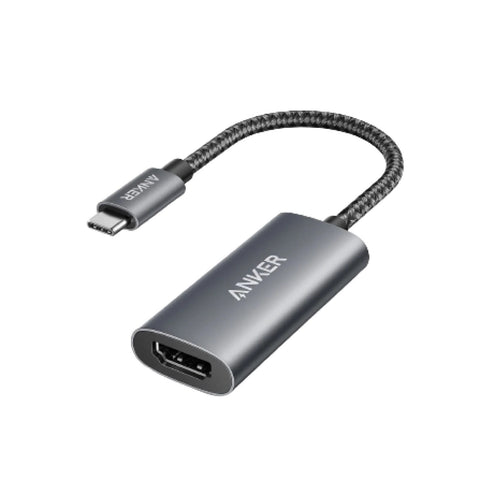
Dispelling the Myth: Do All USB-C Cables Support Video?
Amidst the universal surge of USB-C cables, numerous users wonder whether do all USB-C cables support video playback seamlessly. This article ventures into the world of widely-used connectors—exploring their functionalities, identifying key criteria for choosing the optimal USB-C to USB-C cable for video playback and discussing alternative solutions for playing videos with USB-C. Join us, as we unravel the questions surrounding this versatile and essential component found within modern technological devices.

An overview of USB-C cable
USB-C, also known as USB Type-C, is a marvel of technology standard, especially in cables and connections. Unlike its predecessors, it boasts a reversible design which eliminates the perennial challenge of inserting a USB in the correct orientation. Modern and sophisticated, USB-C provides a one-size-fits-all solution for charging and data transfer across devices ranging from laptops, tablets, phones, to even gaming consoles. Further, it's gradually being accepted as the universal charging standard, promising up to 100 Watts of power delivery.
The remarkable trait of USB-C doesn't end with its versatility in charging and data transfer but extends to its potential in consolidating several cables into a single universal cable. So, does USB-C carry audio and video? With its superior data transfer rate (up to 10 Gbps with USB 3.1), it can carry data, video, audio, and power simultaneously. This multipurpose functionality is achieved through the support of different modes such as DisplayPort and HDMI over USB-C, and protocols including Thunderbolt 3 and USB4.
What to look for in a USB-C to USB-C cable to play a video?
When selecting a USB-C to USB-C cable mainly for video play, it's essential to look for the following features:
DisplayPort Alternate Mode (DP Alt Mode)
DP Alt Mode on USB Type-C allows the cable to carry DisplayPort signals. Therefore, it enables the usage of adaptors that can output DisplayPort, HDMI, VGA, DVI, etc. Choose a cable that explicitly supports DP Alt Mode to ensure exceptional video quality.
Thunderbolt 3 Support
Thunderbolt 3 cables utilize the same connectors as USB-C and can carry audio, video, data, power, and even network traffic. A cable with Thunderbolt 3 support ensures you can transfer videos at a breathtaking speed of up to 40Gbps and connect to high-resolution displays like 4K and 5K monitors.
USB4 Compatibility
Being backward compatible, USB4 cables can connect easily with older USB versions while preserving their features. For video play, USB4 compatibility ensures faster transfer speeds simultaneously with power delivery, offering better performance.
What are some other ways to play a video with USB-C?
Here's a walkthrough of various methods you could consider to play a video using USB-C:
Use USB-C to HDMI or DisplayPort Adapter
One efficient method is to use a USB-C to HDMI or DisplayPort adapter. Ensuring your device(s) are compatible with these ports, simply connect one end of the adapter to your USB-C device, and the other to a television or monitor's HDMI or DisplayPort. This method supports high-definition video and audio transmission, providing stunning image and sound quality.
An excellent choice for this use would be the Anker 518 USB-C Adapter. This adapter comes in two variants, one for DisplayPort and another for HDMI. Both provide you with the convenience of playing 8K resolution video from your device to your display screens.
The Anker 518 USB-C Adapter (8K DisplayPort) offers high-definition video support up to 8K@60Hz or 4K@144Hz for seamless screen mirroring or extension. This plug-and-play adapter transforms your laptop's USB-C port into a DisplayPort without installation, is HDCP-compliant for encrypted content, and is universally compatible with various TVs, monitors, and projectors.

USB-C docking station
Another option is a USB-C docking station, a hub allowing connection between multiple devices. Docking stations often come with a variety of ports e.g., HDMI, VGA, and Ethernet. It allows your USB-C device to connect to different video and audio interfaces, not limited to HDMI or DisplayPort. When coupled with your USB-C device, you can play video on various screens or projectors, providing versatility and convenience.
Use streaming devices
Streaming devices like Google Chromecast or Amazon Fire Stick also support video playback via USB-C. Using these devices involves connecting them to your TV's HDMI port and supplying power with USB-C cables. Once set up, you can stream videos from your mobile devices or services like Netflix and YouTube to your TV.
Conclusion
There you go! If you've ever wondered, "Do all USB-C cables support video?" now, you've got the answer locked down. It's more than just plugging and playing; it's about securing the right cable that facilitates your video enjoyment. With a keen eye on what your USB-C cable can deliver, you'll unlock limitless possibilities to enhance your multimedia experiences. No video is unplayable anymore because you can now never miss a pixel with USB-C!
FAQ
Here are some commonly asked questions about ‘do all USB-C cables support video’.
Can I use any USB-C cable to connect to monitor?
Can USB-C carry video? While many can connect to a monitor, not all of them support video functionality. To ensure a successful connection, you must use a USB-C cable that is specifically designed to support video transmission, such as a USB-C cable with DisplayPort Alt Mode or Thunderbolt 3.
Are all USB-C cables the same for video?
No, not all USB-C cables are the same for video. There are different types of USB-C cables with varying capabilities. For video transmission, be sure to select a cable that supports DisplayPort Alt Mode or Thunderbolt 3, which have been designed for higher resolution and refresh rates required for video.
How do I know if USB-C cable supports video?
To determine if a USB-C cable supports video, check the cable's specifications listed by the manufacturer. Look for terms like "DisplayPort Alt Mode" or "Thunderbolt 3" in the product description or on the packaging, as these are indications that the cable is specifically designed to support video transmission.
Is USB-C better for video than HDMI?
USB-C video cables can be better than HDMI for video in certain cases due to their versatility. USB-C supports video, data transfer, and power delivery through a single cable, using standards like DisplayPort Alt Mode. However, HDMI excels in direct video output with broad compatibility, especially with TVs and monitors. So USB-C is more suitable for laptops and mobile devices, while HDMI is preferred for home entertainment setups.
Why does my monitor have a USB-C cable?
Your monitor includes a USB-C video cable likely because it supports video input via USB-C, a common feature in newer monitors that simplifies connectivity. The USB-C cables for monitors can transmit video, audio, data, and power simultaneously, allowing you to connect your monitor to a laptop or other devices without the need for multiple cables.
Be the First to Know

Save Up to $20 or Get 15% Off
Already signed up? Log in here.
















